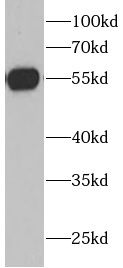Products
HRP-GFP tag Monoclonal antibody
- SPECIFICATIONS
- FIGURES
- CONDITIONS
- FAQS
- Product Name
- HRP-GFP tag Monoclonal antibody
- Catalogue No.
- HRP-03434
- Form
- liquid
- Purification
- Protein A+G purification
- Purity
- ≥95% as determined by SDS-PAGE
- Conjugation
- HRP
- Clonality
- monoclonal
- Isotype
- IgG1
- Clone ID
- 0D8
- Storage
- PBS with 0.02% sodium azide and 50% glycerol pH 7.3, -20℃ for 12 months(Avoid repeated freeze / thaw cycles.)
- Immunogen
- GFP tag
- Alternative Names
- CFP|eGFP|eYFP|GFP|GFP tag|YFP antibody
- UniProt ID
- P42212
- Observed MW
- 30 kDa
- Tested Applications
- WB
- Recommended dilution
- WB: 1:2000-1:10000
 eGFP-tagged fusion protein were subjected to SDS PAGE followed by western blot at dilution of 1:5000
eGFP-tagged fusion protein were subjected to SDS PAGE followed by western blot at dilution of 1:5000
- Background
- Green fluorescence protein(GFP) is a protein composed of 238 amino acid residues(26.9kDa) derived from the Jellyfish Aequorea victoria, which emits green light(emission peak at 509nm) when excited by blue light(excitation peak at 395nm). GFP has become an invaluable tool in cell biology research, since its intrinsic fluorescence can be visualized in living cells.In contrast to wtGFP, EGFP has a single, strong, red-shifted excitation peak at 488nm. GFPmut1 fluoresces 35-fold more intensely than wtGFP when excited at 488nm, due to an increase in its extinction coefficient(Em). This antibody is a rabbit polyclonal antibody raised against full-length eGFP and reactive against all variants of Aequorea victoria GFP such as S65T-GFP, RS-GFP, YFP, CFP and eGFP. Note: Do not add Azium(Sodium Azide or Smite) into the dilution buffer. Azium is the HRP inhibitor which decreases the enzyme activity of HRP.
How many times can antibodies be recycled?
First, usually it's not suggested to recycle antibodies. After use, buffer system of antibodies has changed. The storage condition of recycled antibodies for different customers also varies. Thus, the performance efficiency of recycled antibodies can’t be guaranteed. Besides, FineTest ever conducted the antibody recycling assay. Assay results show recycling times of different antibodies also varies. Usually, higher antibody titer allows more repeated use. Customers can determine based on experimental requirements.
Notes: After incubation, we recycle rest antibodies to centrifuge tube and store at 4℃. High titer antibodies can be stored for a minimum of one week. Reuse about three times.
What are components of FineTest antibody buffer?
Components of FineTest antibody buffer are usually PBS with proclin300 or sodium azide, BSA, 50% glycerol. Common preservative is proclin300 or sodium azide, which is widely applied in the lab and industry.
How about the storage temperature and duration of FineTest antibodies?
Most antibodies are stored at -20℃. Directly-labeled flow cytometry antibodies should be stored at 2 - 8℃. The shelf life is one year. If after sales issues for purchased antibodies appear, return or replacement is available. Usually, antibodies can be still used after the one-year warranty. We can offer technical support services.
Is dilution required for FineTest antibodies? What’s the dilute solution?
Directly-labeled flow cytometry antibodies are ready-to-use without dilution. Other antibodies are usually concentrated. Follow the dilution ratio suggested in the manual. Dilute solution for different experiments also varies. Common antibody dilution buffers are acceptable(e.g. PBST, TBST, antibody blocking buffer).
How to retrieve antibodies for immunohistochemistry?
Common retrieval buffers: Tris-EDTA Buffer(pH 9.0); Citrate Buffer(pH 6.0)
Heat induced antibody retrieval:
Method 1: Water-bath heating: Put the beaker with retrieval buffer and slide in the boiling water bath. Keep the boiling state for 15min. Naturally cool to room temperature;
Method 2: Microwave retrieval: Put the beaker with retrieval buffer and slide in the microwave oven. Heat at high power for 5min, Switch OFF for 3min, Heat at medium power for 5min. Naturally cool to room temperature.
How to choose secondary antibodies?
(1) Secondary antibodies react with primary antibodies. Thus, secondary antibodies should be against host species of primary antibodies. E.g. If the primary antibody is derived from rabbit, the relevant secondary antibody should be against rabbit. E.g. goat anti rabbit or donkey anti rabbit.
(2) Choose secondary antibody conjugates according to the experimental type, e.g. ELISA, WB, IHC etc. Common enzyme conjugated secondary antibodies are labelled by HRP, AP etc. Fluorescin or dye labelled secondary antibodies are applied in immunofluorescence and flow cytometry(e.g. FITC, Cy3).
